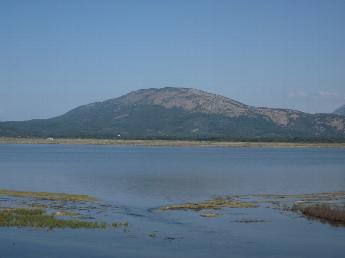A JOINT-VENTURE WITH LOCAL EXPERTS IN SOUTH AFRICA
With the aim of providing customers with the better service ACRENASL and WILDSKIES ECOLOGICAL SERVICES have created a joint venture agreement. Adquired experience from European markets (mainly Spain) may greatly contribute to the project development in South Africa, where the wind industry is currently building up the first wind farms.

The two first projects have been developed both at the Eastern and Western Cape provinces. Cooperation includes the development of appropriate post-construction monitoring methods and use of good practices balancing wind energy production with environmental protection.
This is a great cooperation agreement just after the Department of Energy announced last 29th October that it has issued contracts for wind farms with a total capacity of 787 MW. This is the third round
BIRD AND BAT PRE-CONSTRUCTION MONITORING IS SOUTH AFRICA
The South African market it is greatly growing for the last four years. Many projects are currently under evaluation, field measures or pre construction monitoring. There is a lack of previous experience on the impact of wind turbines on birds.
BirdLife South Africa and the Endangered Wildlife Trust have published the Best Practice Guidelines for Avian Monitoring and Impact Mitigation. They use of the internationally accepted and tested best practices promote a consistent approach across projects. These guidelines have been endorsed by the South African Wind Energy Association-SAWEA.
Our work is based on a joint-venture with our South African partners at Environmental Consultancies, together with guidelines provided to wind developers. Lessons learned from operational turbines in Europe serve us as a strong basis for projects that requiere from appropiate mitigation and correction measures.
The main working area is centered in the Northern Cape, the Great Karoo plains, with other projects also currently under monitoring in the Eastern Cape.
BIODIVERSITY AND ECOSYSTEM SERVICES IN IMPACT ASSESSMENT SYMPOSIUM
(IAIA, WASHINGTON DC, 2013)
Twenty years after the Convention on Biological Diversity was first drafted, the world continues to see unprecedented loss of species. The implications are largely unknown, but the European Commission estimates that by 2050, economic loss due to loss of ecosystem services will amount to 19 trillion USD.
Compounding the challenge are the silos in which the conservation community and the public and private sectors driving development operate. To better integrate conservation science into planning processes, science and practice need to come together to build capacity in the field of impact assessment.
Symposium themes
Baselines and data collection
Biodiversity risk assessment
Biodiversity and extractives
Biodiversity and agriculture
Net positive impact
Forecasting and offset design
Monitoring and adaptive management
Identification and valuation of ecosystem services
Engaging communities on biodiversity and ecosystem services
GIS and landscape analysis
Planning and regional strategies
A growing number of biodiversity initiatives are aimed at creating communities of practice, ranging from cross-sector initiatives across industries to biodiversity working groups comprised of multilateral financial institutions and Equator Principles banks.
The challenge is to better understand how to assess biodiversity values, identify dependence on—and impacts to— ecosystem services, design better mitigation strategies following the mitigation hierarchy, effectively monitor changes in biodiversity and ecosystem services over time, and implement adaptive management to manage uncertainties over the long term.
BUSINESS & BIODIVERSITY WORKSHOP (LISBON, 2012)
The workshop was held on 29 June 2012. Participants discussed how impacts on biodiversity by wind energy projects could be decreased. The speakers showed the participants practical solutions to real world problems. The workshop was organised together with EDP, Bio3 and the Fundacion Global Nature.
Wind power has become a major energy source in the last years and has been accompanied with environmental concerns. Pratical tools and case studies on how the environmental aspects can be measured properly and be taken into account most effectively were shown during the workshop.
The event brought together 43 experts from several European public and private entities. The background of the participants ranged from industry and production of wind energy to environmental assessment and monitoring of impacts on biodiversity. The workshop was moderated by António Sá da Costa, president of APREN (Portuguese Renewable Energy Association), who led the work throughout the day: twelve oral presentations and three working groups for a "World Café” discussion session. Wind power has become a major energy source in the last years and has been accompanied with environmental concerns.
POST-CONSTRUCTION BIRD AND BAT MONITORING OF WIND FARMS IN SPAIN
Sice 2000 our team has been developing Environmental Impact Assessments (EIA), pre and post construction monitoring at Wind Energy Facilities all over Spain: Castilla y León, Castilla la Mancha, Catalonia, Valencia, La Rioja and Basque Regions.We work for both private Developers, companies and Public Bodies.
CORRECTION AND MITIGATION MEASURES: REDUCING GRIFFON VULTURE FATALITIES IN EASTERN SPAIN (2008-2010)
In 2008-2010, together with the Developer and EIN Engineer Company we turned into operation again 32 turbines that were shut down as a consequence of the high number of fatalities recorded in Castellón province, Eastern Spain
As a consequence of the "mad-cow" disease (Bonive Spongiform Encephalopathy (BSE) Griffon Vulture Gyps fulvus fatalities greatly increased. The effect of external factors to the already operating turbines may turn the pre-construction monitoring useless.
An ambitious applied research programme financed by the Developer included satellite tracking GPS/ARGOS, wing tagging, the opening and food provision at two vulture restaurants let to reduce the fatality rates by 68% percent within two years, turning the breeding vulture population to previous existing numbers.
Results and detailed explanations of the Adaptive Management Plan- AMP has been shared at the most relevant Meetings on Wind Energy in Europe and worlwide.
PRE-CONSTRUCTION BIRD MONITORING OF A WIND FARM IN ULCINJ (MONTENEGRO)
In 2010-2011 we were hired for supervising the pre-construction bird monitoring of a wind farm in Ulcinj municipality (Montenegro), Balkan Peninsula.
After Montenegro was nominated as EU candidate at 18th December 2010 the Government had a compromise to fulfill the European Birds and Habitats Directive. The deep involvement of the developer on this task, ensures its development accomplish with the best EU European Environmental standards.

.